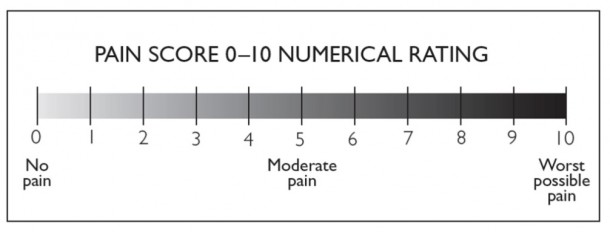Pain (any cause) Nurse Management Guidelines
Red Flag Exclusion Criteria
Child at risk of significant harm
Suspected non-accidental injury
Unplanned repeat ED presentation
Infant < 6 months
Pain score ≥ 7
Chest pain
Abdominal pain
History of workplace injury
Yellow or Red Zones observations or additional criteria outlined in the NSW Health Standard Observation Charts
Additional Observations
Complete formal assessment of pain using one of the following methods.
Numerical rating score
Appropriate for patients aged 6-8 years and over
Ask patient ro rate pain on scale below (either verbal or point on scale)

Figure 1- National Institute of Clinical Studies (2011) Emergency Care Pain Management Manual
Pain Score Severity
No pain = Pain Score of 0
Mild pain = Pain Score of 1-3
Moderate pain = Pain Score of 4-6
Severe pain = Pain Score ≥7 (Red Flag)
Faces Rating Scale
Can be used for younger children (≥ 4 years). Also work well for people with a culturally or linguistically diverse background (CALD).
Ask patient to choose the face that best describes how they feel

Figure 2- National Institute of Clinical Studies (2011) Emergency Care Pain Management Manual / International Association for the Study of Pain
FLACC Behavioural Pain Assessment Scale
Can be used for paediatrics between 2 months and 7 years (also CALD).
Each of the 5 aspects is scored from 0 - 2. Scores are tallied to give a pain score 0 - 10.

Figure 3- National Institute of Clinical Studies (2011) Emergency Care Pain Management Manual / © University of Michigan Health System
Additional History
- Thorough pain assessment:
Circumstances of pain onset / relieving factors
Location / intensity / radiation / characteristics of pain
Any other associated symptoms
Any treatment including previous medications
Medical / surgical history
Management Principles
According to pain scale and medication standing orders, administer paracetamol or Panadeine®
Mild pain → paracetamol
Moderate pain → Panadeine®or consider administration of paracetamol and ibuprofen as per standing orders dosing schedule
Under the following circumstances, administer ibuprofen for mild pain as an alternative to paracetamol
Allergy or contra-indication to paracetamol
Patient has received 1g of paracetamol within the last 4 hours
Patient has received 4g of paracetamol within the last 24 hours
If patient has associated nausea, consider administration of an antiemetic as per Standing Orders
Ondansetron 4mg tablet / wafer
OR
For adult patients ≥ 20 years only, administer metoclopramide with the following considerations:
Tablet: if patient has not vomited in the past hour and is tolerating small frequent amounts of oral fluid
Parenteral: if patient is currently vomiting and is unable to tolerate small amounts of oral fluid
- Reassess patient using appropriate pain scale to assess effectiveness of intervention
Document assessment findings, intervention and outcomes.
References / Further Resources
ECI Patient Factsheet - Pain Management
ECI Patient Factsheet - Back Pain